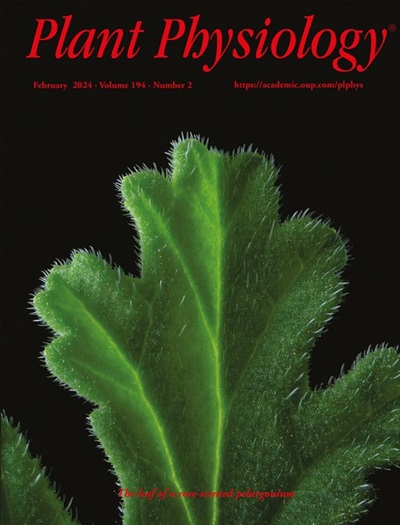Carbon and nitrogen signaling regulate FLOWERING LOCUS C and impact flowering time in Arabidopsis
IF 6.5
1区 生物学
Q1 PLANT SCIENCES
引用次数: 0
Abstract
The timing of flowering in plants is modulated by both carbon (C) and nitrogen (N) signaling pathways. In a previous study, we established a pivotal role of the sucrose-signaling trehalose 6-phosphate pathway in regulating flowering under N-limited short-day conditions. In this work, we show that both wild-type Arabidopsis (Arabidopsis thaliana) plants grown under N-limited conditions and knock-down plants of TREHALOSE PHOSPHATE SYNTHASE 1 induce FLOWERING LOCUS C (FLC) expression, a well-known floral repressor associated with vernalization. When exposed to an extended period of cold, a flc mutant fails to respond to N availability and flowers at the same time under N-limited and full-nutrition conditions. Our data suggest that SUCROSE NON-FERMENTING 1 RELATED KINASE 1-dependent trehalose 6-phosphate-mediated C signaling and a mechanism downstream of N signaling (likely involving NIN-LIKE PROTEIN 7) impact the expression of FLC. Collectively, our data underscore the existence of a multi-factor regulatory system in which the C and N signaling pathways jointly govern the regulation of flowering in plants.碳信号和氮信号调控拟南芥的花序定位点 C 并影响其开花时间
植物的开花时间受碳(C)和氮(N)信号途径的调节。在之前的一项研究中,我们确定了蔗糖-6-磷酸三卤糖信号途径在氮限制的短日照条件下调节开花的关键作用。在这项研究中,我们发现在氮限制条件下生长的野生型拟南芥(Arabidopsis thaliana)植株和三卤糖磷酸合成酶 1 的基因敲除植株都能诱导花序抑制因子 C(FLC)的表达,FLC 是一种与春化相关的著名花序抑制因子。当暴露于较长时间的低温时,flc 突变体不能对氮的可用性做出反应,并在氮限制和全营养条件下同时开花。我们的数据表明,依赖于 6-磷酸三卤糖介导的 C 信号转导和 N 信号转导下游机制(可能涉及 NIN-LIKE PROTEIN 7)影响了 FLC 的表达。总之,我们的数据强调了多因素调控系统的存在,其中 C 信号途径和 N 信号途径共同调控植物开花。
本文章由计算机程序翻译,如有差异,请以英文原文为准。
求助全文
约1分钟内获得全文
求助全文
来源期刊

Plant Physiology
生物-植物科学
CiteScore
12.20
自引率
5.40%
发文量
535
审稿时长
2.3 months
期刊介绍:
Plant Physiology® is a distinguished and highly respected journal with a rich history dating back to its establishment in 1926. It stands as a leading international publication in the field of plant biology, covering a comprehensive range of topics from the molecular and structural aspects of plant life to systems biology and ecophysiology. Recognized as the most highly cited journal in plant sciences, Plant Physiology® is a testament to its commitment to excellence and the dissemination of groundbreaking research.
As the official publication of the American Society of Plant Biologists, Plant Physiology® upholds rigorous peer-review standards, ensuring that the scientific community receives the highest quality research. The journal releases 12 issues annually, providing a steady stream of new findings and insights to its readership.
 求助内容:
求助内容: 应助结果提醒方式:
应助结果提醒方式:


